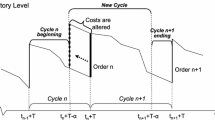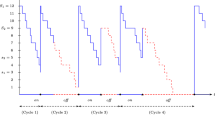Abstract
This paper models a retailer’s response to temporary manufacturer’s trade deals characterized by a time interval of random length, but with the ending date known before its occurrence. Uncertainty is handled through a reordering point, which serves as a trigger mechanism for a new special order and is activated at the discount termination date. The model generates ordering policies, applicable to any probability distribution and is shown to yield well-known deterministic optimal policies as a limiting case.
Similar content being viewed by others
References
Ailawadi, K., & Farris, P. (1999). Trade promotion: Essential to selling through retailers. Sloan Management Review, 41, 83–95.
Arcelus, F. J., & Srinivasan, G. (1995). Discount strategies for one-time-only sales. IIE Transactions, 27, 618–624.
Bednar, J. (2005). Like one of the family. Business West, 22(9), 44–47.
Güllü, R., Önol, E., & Erkip, N. (1999). An analysis of an inventory system under supply uncertainty. International Journal of Production Economics, 59, 377–385.
Gürler, Ü, & Parlar, M. (1997). An inventory problem with two randomly available suppliers. Operations Research, 45, 904–918.
Hosken, D., & Reiffen, D. (2004). Patterns of retail price variation. RAND Journal of Economics, 35, 128–146.
Khang, D. B., & Fujiwara, O. (2000). Optimality of myopic ordering policies for inventory models with stochastic supply. Operations Research, 48, 181–184.
Leech, P. (2002). The shaq factor and other problems. Progressive Grocer, 81(11), 27–28.
Lev, B., & Weiss, H. A. (1990). Inventory models with cost changes. Operations Research, 38, 53–63.
Matlab (2005). Optimization toolbox: User’s guide. Natick: The Math Works, Inc.
Neslin, S. A. (2002). Sales promotions. In Weitz B. A. & Wensley R. (Eds.), Handbook of marketing (pp. 310–328). London: Sage.
Naddor, E. (1966). Inventory Systems. New York: John Wiley.
Parlar, M. (2000). Probabilistic analysis of renewal cycles: An application to a non-Markovian inventory problem with multiple objectives. Operations Research, 48, 243–255.
Silver, E. A. (1999). Simple replenishment rules when payment periods (dating deals) are present. Production and Inventory Management Journal, 40, 1–7.
Silver, E. A., Robb, D. J., & Rahnama, M. N. (1993). Random opportunities for reduced cost replacements. IIE Transactions, 25, 111–120.
Tyagi, R. K. (1999). A characterization of retail response to manufacturing trade deals. Journal of Marketing Research, 36, 510–516.
Wellman, D. (2000). Frozen food allowances rise. Frozen Food Age, 48(11), 10.
Author information
Authors and Affiliations
Corresponding author
Rights and permissions
About this article
Cite this article
Arcelus, F., Pakkala, T.P.M. & Srinivasan, G. Retailer’s inventory policies for a one time only manufacturer trade deal of uncertain duration. Ann Oper Res 164, 3–15 (2008). https://doi.org/10.1007/s10479-007-0256-3
Received:
Accepted:
Published:
Issue Date:
DOI: https://doi.org/10.1007/s10479-007-0256-3




